Community Forum
Horse World Online
Breed horses and ponies, raise your foals, and train the next champion in this exciting and realistic online horse breeding game.
The new layout is in beta testing and we're inviting you to help us try it out! Click here to read the announcement post for details.
Feeding For Weight and Temperament - A Guide
9 posts
• Page 1 of 1
-
Silverine

- Posts: 1795
- Joined: Wed May 17, 2017 3:13 am
- Visit My Farm
Feeding For Weight and Temperament - A Guide
Post by Silverine »
I was going to post this with my beginner guide, but decided that it needed its own thread.
First off: If you are not going to compete your horse you don't need to worry about weight or temperament. A horse will suffer no ill effects from being too fat or too thin, and it will not die if it is not eating enough. At the moment the only things that are affected by weight and temperament are a horse's competition scores.
Weight
HWO has seven different weight classes: Very Fat, Fat, Moderately Fleshy, Moderate, Moderately Thin, Thin, and Poor. Horses from moderately fleshy to moderately thin are generally considered to be at a good weight, with moderate seen as the ideal for unspecialized horses.
Horses specialized for certain disciplines will want to be in certain weight classes. For example, race horses benefit from a Moderately Thin weight rating whereas a dressage horse will benefit from a Moderately Fleshy rating. If you are not sure what you want to compete your horse in, or you want it to compete in multiple different disciplines, Moderate is the way to go. You can adjust a horse's weight by feeding it different amounts.
Temperament
HWO has five different temperaments: Bombproof, Calm, Even-Tempered, Spirited, and High Strung. You can find your horse's temperament in its "Attribute" section, right under its build. Each discipline has a different temperament that is best suited for it. Continuing with our racing and dressage examples, race horses perform best at High Strung where as dressage horses tend to perform better at Even-Tempered. If you're not sure where you want to keep your horse it's okay to leave it either Bombproof or High Strung, the two easiest temperaments to maintain, though it may not score as well.
Please also that not all horses can change temperament. Some horses are born one temperament and will stay that way for their entire life no matter what you try to change it. That's just the way the game works. Temperament is also heritable between horses - meaning that parents pass down some of their temperament to their children. If a horse is stuck at bombproof there is a higher chance that its offspring will also be stuck at bombproof.
Feeding to Change Weight and Temperament
We'll start with weight, as changing a horse's weight is much simpler than changing its temperament. Each horse has a "Feeding" section on its page, located in the left-hand bar under the Attributes section. In this section, under what your horse is eating, is a percentage next to the heading "Daily Energy":
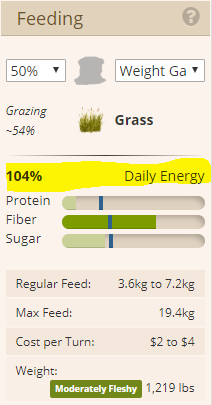 This percentage is what will change your horse's weight. Feeding any percentage lower than 100% will cause a horse to lose weight. Feeding any percentage greater than 105% will cause a horse to gain weight. Percentages from 100%-105% should allow a horse to maintain its weight.
This percentage is what will change your horse's weight. Feeding any percentage lower than 100% will cause a horse to lose weight. Feeding any percentage greater than 105% will cause a horse to gain weight. Percentages from 100%-105% should allow a horse to maintain its weight.
If your horse is eating 100% or greater in a pasture you will need to either mow the pasture or put the horse in a barn to get it to lose weight.
There are some caveats to the above. Any horse that is younger than five years is still growing and will require more food to maintain its proper weight. You may find it dropping weight brackets (from moderate to moderately thin, for example) even if eating 100-102% for daily energy. This is normal. Simply bump up its food for a few days and it should gain weight again. Pregnant mares will also have changing food needs during gestation, requiring greater amounts of food near the end of gestation in order to maintain weight. Again, this is normal.
Different horses eat different amounts. Notice in the box that there is a section labelled Max Feed:
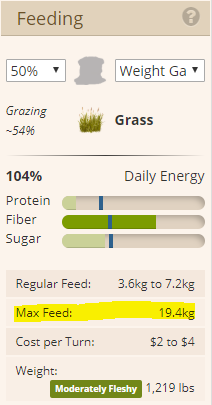 This particular horse is only able to eat, at most, 19.4kg of food per day. This is important to keep in mind when selecting what to feed our horses. Because each feed only supplies a certain amount of energy per weight.
This particular horse is only able to eat, at most, 19.4kg of food per day. This is important to keep in mind when selecting what to feed our horses. Because each feed only supplies a certain amount of energy per weight.
While on pasture, the above horse gets 54% of his energy from grass, meaning that he needs to get 50% of his energy from a secondary source in order to maintain his weight. Here is table of the weight of the food he would need to eat to reach that energy level for each different food:
As you can see, you'd need to feed a lot of hay to get 50% of this horse's energy from it and he just can't eat that much! On the other hand, feeding him weight gain mix will keep us comfortably within his maximum. If feeding a horse a chosen amount would go over its maximum allowed feed your weight boxes will turn red as a warning. Like this:
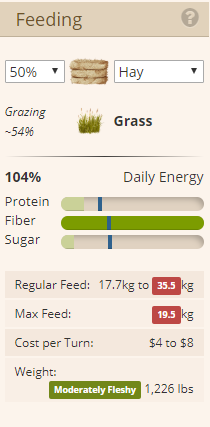 When you see this, your horse will not have full energy or gain weight, no matter how high you set the value, because your horse simply can't eat that much!
When you see this, your horse will not have full energy or gain weight, no matter how high you set the value, because your horse simply can't eat that much!
The best way to get a handle on feeding values is to go to one of your horses and play around yourself to see what does what.
Now that we have a handle on how much to feed a horse, lets take a look at how feeding effects temperament. In the feeding section you will see three bars labelled Protein, Fiber, and Sugar.
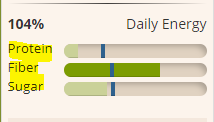 Each of these has different effects on temperament, and each feed type fills each bar a different amount. Here's a breakdown of what these three things do:
Each of these has different effects on temperament, and each feed type fills each bar a different amount. Here's a breakdown of what these three things do:
So if you have a High Strung horse and want to lower its temperament you will want to feed it a lot of fiber and if you have Bombproof horse and want to increase its temperament you will want to feed it a lot of sugar. If you want your horse to maintain a specific temperament you should feed it as close to an even mix of fiber and sugar as you can.
Each feed has a different makeup of protein, fiber, and sugar. Grass from pasture has the highest fiber content and is the best place to keep your horse if you want to lower its temperament. In contrast, if you want a horse to increase its temperament (or to maintain its temperament at anything other than Bombproof) it's best to keep it in a barn.
Here's a breakdown of what each feed gives a horse:
Note: The visuals above were taken if feeding the horse 100% of that particular type of feed. Feeding lower amounts will fill the bar less than in the above image.
Looking at the visuals you may have noticed a blue bar. This blue bar usually doesn't matter much, but it's important for changing temperament. If you want to increase a horse's temperament you need to fill the sugar bar to at least the blue bar, and have the fiber bar be smaller than the sugar bar. In the above table, the settings for Yellow Corn, Oats, Sweet Feed, Performance Mix, and Weight Gain Mix would all increase a horse's temperament. To decrease a horse's temperament you need to fill the fiber bar to at least the blue bar, and have the sugar bar be smaller than the fiber bar. In the above table the settings for Hay, Alfalfa Hay, and Alfalfa Cubes would all decrease a horse's temperament.
If you want to keep a horse's temperament where it is, you'll want their protein, fiber, and sugar to look something like this: Notice the even levels of fiber and sugar. However, this will not guarantee that your horse will stay at it's current temperament. Even at equal levels many horses will still fluctuate one way or another, but the equal levels will slow that progression. Just keep an eye on your horse and adjust the feed levels as needed.
Notice the even levels of fiber and sugar. However, this will not guarantee that your horse will stay at it's current temperament. Even at equal levels many horses will still fluctuate one way or another, but the equal levels will slow that progression. Just keep an eye on your horse and adjust the feed levels as needed.
Silverine's Guides - Quick Links
Step-by-Step Beginner Guide
Feeding For Weight And Temperament - You are here.
Quest Breeding Guide
Discipline Potential Evaluation
Evaluating Stud Quality
Feeding on HWO can be a somewhat complicated undertaking but is also very important. What you feed your horse controls both how much it weighs and what temperament it displays.Step-by-Step Beginner Guide
Feeding For Weight And Temperament - You are here.
Quest Breeding Guide
Discipline Potential Evaluation
Evaluating Stud Quality
First off: If you are not going to compete your horse you don't need to worry about weight or temperament. A horse will suffer no ill effects from being too fat or too thin, and it will not die if it is not eating enough. At the moment the only things that are affected by weight and temperament are a horse's competition scores.
Weight
HWO has seven different weight classes: Very Fat, Fat, Moderately Fleshy, Moderate, Moderately Thin, Thin, and Poor. Horses from moderately fleshy to moderately thin are generally considered to be at a good weight, with moderate seen as the ideal for unspecialized horses.
Horses specialized for certain disciplines will want to be in certain weight classes. For example, race horses benefit from a Moderately Thin weight rating whereas a dressage horse will benefit from a Moderately Fleshy rating. If you are not sure what you want to compete your horse in, or you want it to compete in multiple different disciplines, Moderate is the way to go. You can adjust a horse's weight by feeding it different amounts.
Temperament
HWO has five different temperaments: Bombproof, Calm, Even-Tempered, Spirited, and High Strung. You can find your horse's temperament in its "Attribute" section, right under its build. Each discipline has a different temperament that is best suited for it. Continuing with our racing and dressage examples, race horses perform best at High Strung where as dressage horses tend to perform better at Even-Tempered. If you're not sure where you want to keep your horse it's okay to leave it either Bombproof or High Strung, the two easiest temperaments to maintain, though it may not score as well.
Please also that not all horses can change temperament. Some horses are born one temperament and will stay that way for their entire life no matter what you try to change it. That's just the way the game works. Temperament is also heritable between horses - meaning that parents pass down some of their temperament to their children. If a horse is stuck at bombproof there is a higher chance that its offspring will also be stuck at bombproof.
Feeding to Change Weight and Temperament
We'll start with weight, as changing a horse's weight is much simpler than changing its temperament. Each horse has a "Feeding" section on its page, located in the left-hand bar under the Attributes section. In this section, under what your horse is eating, is a percentage next to the heading "Daily Energy":

If your horse is eating 100% or greater in a pasture you will need to either mow the pasture or put the horse in a barn to get it to lose weight.
There are some caveats to the above. Any horse that is younger than five years is still growing and will require more food to maintain its proper weight. You may find it dropping weight brackets (from moderate to moderately thin, for example) even if eating 100-102% for daily energy. This is normal. Simply bump up its food for a few days and it should gain weight again. Pregnant mares will also have changing food needs during gestation, requiring greater amounts of food near the end of gestation in order to maintain weight. Again, this is normal.
Different horses eat different amounts. Notice in the box that there is a section labelled Max Feed:

While on pasture, the above horse gets 54% of his energy from grass, meaning that he needs to get 50% of his energy from a secondary source in order to maintain his weight. Here is table of the weight of the food he would need to eat to reach that energy level for each different food:
| Feed | Weight to reach 50% |
| Hay | 35.5kg |
| Alfalfa Hay | 38kg |
| Alfalfa Cubes | 34.7kg |
| Yellow Corn | 10.9kg |
| Oats | 14.6kg |
| Sweet Feed | 11.4kg |
| Performance Mix | 10.3kg |
| Weight Gain Mix | 7.3kg |

The best way to get a handle on feeding values is to go to one of your horses and play around yourself to see what does what.
Now that we have a handle on how much to feed a horse, lets take a look at how feeding effects temperament. In the feeding section you will see three bars labelled Protein, Fiber, and Sugar.

| Protein | Does not affect temperament itself, but increases the effect of fiber and sugar. |
| Fiber | Lowers a horse's temperament. |
| Sugar | Increases a horse's temperament. |
Each feed has a different makeup of protein, fiber, and sugar. Grass from pasture has the highest fiber content and is the best place to keep your horse if you want to lower its temperament. In contrast, if you want a horse to increase its temperament (or to maintain its temperament at anything other than Bombproof) it's best to keep it in a barn.
Here's a breakdown of what each feed gives a horse:
| Feed | Protein | Fiber | Sugar | Visual |
| Hay | Low | Very High | Very Low |  |
| Alfalfa Hay | Moderate | Very High | Low |  |
| Alfalfa Cubes | Moderate | Extremely High | Extremely Low |  |
| Yellow Corn | Extremely Low | Extremely Low | Extremely High |  |
| Oats | Very Low | Very Low | Extremely High |  |
| Sweet Feed | Very Low | Low | Extremely High |  |
| Performance Mix | High | Very Low | High |  |
| Weight Gain Mix | Extremely Low | Extremely Low | Very High |  |
Looking at the visuals you may have noticed a blue bar. This blue bar usually doesn't matter much, but it's important for changing temperament. If you want to increase a horse's temperament you need to fill the sugar bar to at least the blue bar, and have the fiber bar be smaller than the sugar bar. In the above table, the settings for Yellow Corn, Oats, Sweet Feed, Performance Mix, and Weight Gain Mix would all increase a horse's temperament. To decrease a horse's temperament you need to fill the fiber bar to at least the blue bar, and have the sugar bar be smaller than the fiber bar. In the above table the settings for Hay, Alfalfa Hay, and Alfalfa Cubes would all decrease a horse's temperament.
If you want to keep a horse's temperament where it is, you'll want their protein, fiber, and sugar to look something like this:

Last edited by Silverine on Fri Feb 07, 2020 12:30 am, edited 4 times in total.

Silverine's Guides - Quick Links
Step-by-Step Beginner Guide
Feeding For Weight And Temperament
Quest Breeding Guide
Discipline Potential Evaluation
Evaluating Stud Quality
-
Silverine

- Posts: 1795
- Joined: Wed May 17, 2017 3:13 am
- Visit My Farm
Re: Feeding For Weight and Temperament - A Guide
Post by Silverine »
Solutions to Common Problems
I'm feeding my horse 400% but it won't gain weight!!!
So you have your horse in a barn, are feeding it a bunch of stuff, and still can't get it to gain weight. Believe it or not this is a common problem. It stems from a misunderstanding of the feeding system.
First, does your horse's feed box look like this?
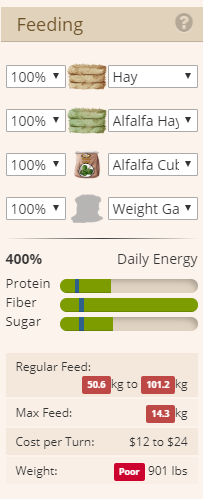
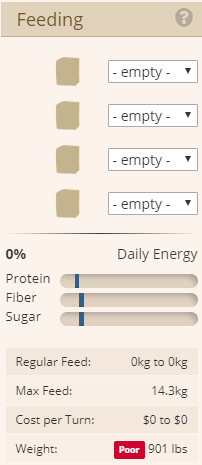
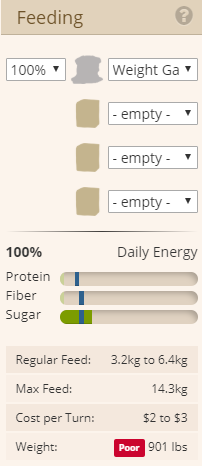
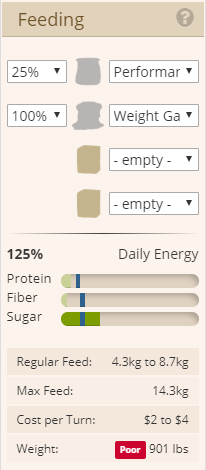
Using this system your horse will gain weight slowly and steadily.
My horse won't lose weight!!!
Is your horse in a pasture? If so, it's possible the pasture is keeping it fat. Try moving it to a barn.
Is your horse in a barn? If so, is it being fed in that barn? If it has any food in its feed box try removing the food.
But my horse is in a barn and not eating food but still won't lose weight!
This is a known issue with the game. Some particularly large horses have a bug where they simply can't lose weight once they hit a certain point. Some players have had luck with keeping the horse in a barn and setting its feed to 95% Yellow Corn, but this hasn't worked for everyone.
In the end, don't worry if you can't get your horse to lose weight. Some horses just can't, and your horse will not be negatively affected by being fat.

Silverine's Guides - Quick Links
Step-by-Step Beginner Guide
Feeding For Weight And Temperament
Quest Breeding Guide
Discipline Potential Evaluation
Evaluating Stud Quality
-
Soaring Hooves

- Posts: 3205
- Joined: Thu Nov 21, 2019 1:09 am
- Location: With my dog :)
- Visit My Farm
Re: Feeding For Weight and Temperament - A Guide
Post by Soaring Hooves »
Thank you for this, it's very helpful!
Silverine wrote:I was going to post this with my beginner guide, but decided that it needed its own thread.
Silverine's Guides - Quick LinksFeeding on HWO can be a somewhat complicated undertaking but is also very important. What you feed your horse controls both how much it weighs and what temperament it displays.
Step-by-Step Beginner Guide
Feeding For Weight And Temperament - You are here.
Quest Breeding Guide
Discipline Potential Evaluation
Evaluating Stud Quality
First off: If you are not going to compete your horse you don't need to worry about weight or temperament. A horse will suffer no ill effects from being too fat or too thin, and it will not die if it is not eating enough. At the moment the only things that are affected by weight and temperament are a horse's competition scores.
Weight
HWO has seven different weight classes: Very Fat, Fat, Moderately Fleshy, Moderate, Moderately Thin, Thin, and Poor. Horses from moderately fleshy to moderately thin are generally considered to be at a good weight, with moderate seen as the ideal for unspecialized horses.
Horses specialized for certain disciplines will want to be in certain weight classes. For example, race horses benefit from a Moderately Thin weight rating whereas a dressage horse will benefit from a Moderately Fleshy rating. If you are not sure what you want to compete your horse in, or you want it to compete in multiple different disciplines, Moderate is the way to go. You can adjust a horse's weight by feeding it different amounts.
Temperament
HWO has five different temperaments: Bombproof, Calm, Even-Tempered, Spirited, and High Strung. You can find your horse's temperament in its "Attribute" section, right under its build. Each discipline has a different temperament that is best suited for it. Continuing with our racing and dressage examples, race horses perform best at High Strung where as dressage horses tend to perform better at Even-Tempered. If you're not sure where you want to keep your horse it's okay to leave it either Bombproof or High Strung, the two easiest temperaments to maintain, though it may not score as well.
Please also that not all horses can change temperament. Some horses are born one temperament and will stay that way for their entire life no matter what you try to change it. That's just the way the game works. Temperament is also heritable between horses - meaning that parents pass down some of their temperament to their children. If a horse is stuck at bombproof there is a higher chance that its offspring will also be stuck at bombproof.
Feeding to Change Weight and Temperament
We'll start with weight, as changing a horse's weight is much simpler than changing its temperament. Each horse has a "Feeding" section on its page, located in the left-hand bar under the Attributes section. In this section, under what your horse is eating, is a percentage next to the heading "Daily Energy":
This percentage is what will change your horse's weight. Feeding any percentage lower than 100% will cause a horse to lose weight. Feeding any percentage greater than 105% will cause a horse to gain weight. Percentages from 100%-105% should allow a horse to maintain its weight.
If your horse is eating 100% or greater in a pasture you will need to either mow the pasture or put the horse in a barn to get it to lose weight.
There are some caveats to the above. Any horse that is younger than five years is still growing and will require more food to maintain its proper weight. You may find it dropping weight brackets (from moderate to moderately thin, for example) even if eating 100-102% for daily energy. This is normal. Simply bump up its food for a few days and it should gain weight again. Pregnant mares will also have changing food needs during gestation, requiring greater amounts of food near the end of gestation in order to maintain weight. Again, this is normal.
Different horses eat different amounts. Notice in the box that there is a section labelled Max Feed:
This particular horse is only able to eat, at most, 19.4kg of food per day. This is important to keep in mind when selecting what to feed our horses. Because each feed only supplies a certain amount of energy per weight.
While on pasture, the above horse gets 54% of his energy from grass, meaning that he needs to get 50% of his energy from a secondary source in order to maintain his weight. Here is table of the weight of the food he would need to eat to reach that energy level for each different food:
As you can see, you'd need to feed a lot of hay to get 50% of this horse's energy from it and he just can't eat that much! On the other hand, feeding him weight gain mix will keep us comfortably within his maximum. If feeding a horse a chosen amount would go over its maximum allowed feed your weight boxes will turn red as a warning. Like this:
Feed Weight to reach 50% Hay 35.5kg Alfalfa Hay 38kg Alfalfa Cubes 34.7kg Yellow Corn 10.9kg Oats 14.6kg Sweet Feed 11.4kg Performance Mix 10.3kg Weight Gain Mix 7.3kg
When you see this, your horse will not have full energy or gain weight, no matter how high you set the value, because your horse simply can't eat that much!
The best way to get a handle on feeding values is to go to one of your horses and play around yourself to see what does what.
Now that we have a handle on how much to feed a horse, lets take a look at how feeding effects temperament. In the feeding section you will see three bars labelled Protein, Fiber, and Sugar.
Each of these has different effects on temperament, and each feed type fills each bar a different amount. Here's a breakdown of what these three things do:
So if you have a High Strung horse and want to lower its temperament you will want to feed it a lot of fiber and if you have Bombproof horse and want to increase its temperament you will want to feed it a lot of sugar. If you want your horse to maintain a specific temperament you should feed it as close to an even mix of fiber and sugar as you can.
Protein Does not affect temperament itself, but increases the effect of fiber and sugar. Fiber Lowers a horse's temperament. Sugar Increases a horse's temperament.
Each feed has a different makeup of protein, fiber, and sugar. Grass from pasture has the highest fiber content and is the best place to keep your horse if you want to lower its temperament. In contrast, if you want a horse to increase its temperament (or to maintain its temperament at anything other than Bombproof) it's best to keep it in a barn.
Here's a breakdown of what each feed gives a horse:
Note: The visuals above were taken if feeding the horse 100% of that particular type of feed. Feeding lower amounts will fill the bar less than in the above image.
Feed Protein Fiber Sugar Visual Hay Low Very High Very Low Alfalfa Hay Moderate Very High Low Alfalfa Cubes Moderate Extremely High Extremely Low Yellow Corn Extremely Low Extremely Low Extremely High Oats Very Low Very Low Extremely High Sweet Feed Very Low Low Extremely High Performance Mix High Very Low High Weight Gain Mix Extremely Low Extremely Low Very High
Looking at the visuals you may have noticed a blue bar. This blue bar usually doesn't matter much, but it's important for changing temperament. If you want to increase a horse's temperament you need to fill the sugar bar to at least the blue bar, and have the fiber bar be smaller than the sugar bar. In the above table, the settings for Yellow Corn, Oats, Sweet Feed, Performance Mix, and Weight Gain Mix would all increase a horse's temperament. To decrease a horse's temperament you need to fill the fiber bar to at least the blue bar, and have the sugar bar be smaller than the fiber bar. In the above table the settings for Hay, Alfalfa Hay, and Alfalfa Cubes would all decrease a horse's temperament.
If you want to keep a horse's temperament where it is, you'll want their protein, fiber, and sugar to look something like this:Notice the even levels of fiber and sugar. However, this will not guarantee that your horse will stay at it's current temperament. Even at equal levels many horses will still fluctuate one way or another, but the equal levels will slow that progression. Just keep an eye on your horse and adjust the feed levels as needed.
-
Poponover
- Posts: 14
- Joined: Fri Feb 19, 2021 5:46 pm
- Visit My Farm
Re: Feeding For Weight and Temperament - A Guide
Post by Poponover »
I finally figured out what I was doing wrong with my first barn. Thank you!
-
Nightwillow
- Posts: 2
- Joined: Wed Feb 16, 2022 11:59 pm
- Visit My Farm
Re: Feeding For Weight and Temperament - A Guide
Post by Nightwillow »
Thank you Silverine, this is so helpful!
-
Gabby Woodlark
- Posts: 1695
- Joined: Fri May 07, 2021 4:39 pm
- Visit My Farm
Re: Feeding For Weight and Temperament - A Guide
Post by Gabby Woodlark »
I would like to bump this up 
-Gabbs
-Gabbs
-
Diamond Filly
- Posts: 1484
- Joined: Mon Dec 26, 2022 6:02 pm
- Visit My Farm
Re: Feeding For Weight and Temperament - A Guide
Post by Diamond Filly »
Do you have a table or something on what is the highest temperament and what is the lowest? I'm trying to figure out what feed to feed my horse to get his temperament to Spirited.Silverine wrote:-
Horse link: https://www.horseworldonline.net/horse/profile/3606725
-
Silverine

- Posts: 1795
- Joined: Wed May 17, 2017 3:13 am
- Visit My Farm
Re: Feeding For Weight and Temperament - A Guide
Post by Silverine »
I don't but I'm sure there's one somewhere in BlackOak's links.Diamond Filly wrote:Do you have a table or something on what is the highest temperament and what is the lowest? I'm trying to figure out what feed to feed my horse to get his temperament to Spirited.Silverine wrote:-
Horse link: https://www.horseworldonline.net/horse/profile/3606725
Your horse is currently at High Strung, which is the highest temperament. Spirited is one below that. So he needs more fiber and less protein. The easiest way to achieve this is in a pasture.
As Spirited is in the middle of the spectrum rather than at one of the ends you will not be able to keep a horse there indefinitely unless it is frozen. You'll need to keep an eye on his temperament for when it dips too low (Even-Tempered) or too high (High Strung) and adjust accordingly.

Silverine's Guides - Quick Links
Step-by-Step Beginner Guide
Feeding For Weight And Temperament
Quest Breeding Guide
Discipline Potential Evaluation
Evaluating Stud Quality
-
Diamond Filly
- Posts: 1484
- Joined: Mon Dec 26, 2022 6:02 pm
- Visit My Farm
Re: Feeding For Weight and Temperament - A Guide
Post by Diamond Filly »
Okay, thank you!Silverine wrote:I don't but I'm sure there's one somewhere in BlackOak's links.Diamond Filly wrote: Do you have a table or something on what is the highest temperament and what is the lowest? I'm trying to figure out what feed to feed my horse to get his temperament to Spirited.
Horse link: https://www.horseworldonline.net/horse/profile/3606725
Your horse is currently at High Strung, which is the highest temperament. Spirited is one below that. So he needs more fiber and less protein. The easiest way to achieve this is in a pasture.
As Spirited is in the middle of the spectrum rather than at one of the ends you will not be able to keep a horse there indefinitely unless it is frozen. You'll need to keep an eye on his temperament for when it dips too low (Even-Tempered) or too high (High Strung) and adjust accordingly.
9 posts
• Page 1 of 1
Jump to
- General Discussion
- ↳ Announcements
- ↳ Weekly Development Updates
- ↳ General Chit Chat
- ↳ Contests
- ↳ What Colour Is My Horse?
- ↳ Comments and Suggestions
- ↳ Suggestions Archive
- ↳ Breeding Communities
- ↳ Farm Logs
- Marketplace
- ↳ Horses for Sale
- ↳ Stallions at Stud
- Knowledgebase & Guides
- ↳ Gameplay Questions & Help
- ↳ Guides & How To
- Technical
- ↳ Change Log v3
- Guest Discussions
- ↳ Public Questions & Answers
